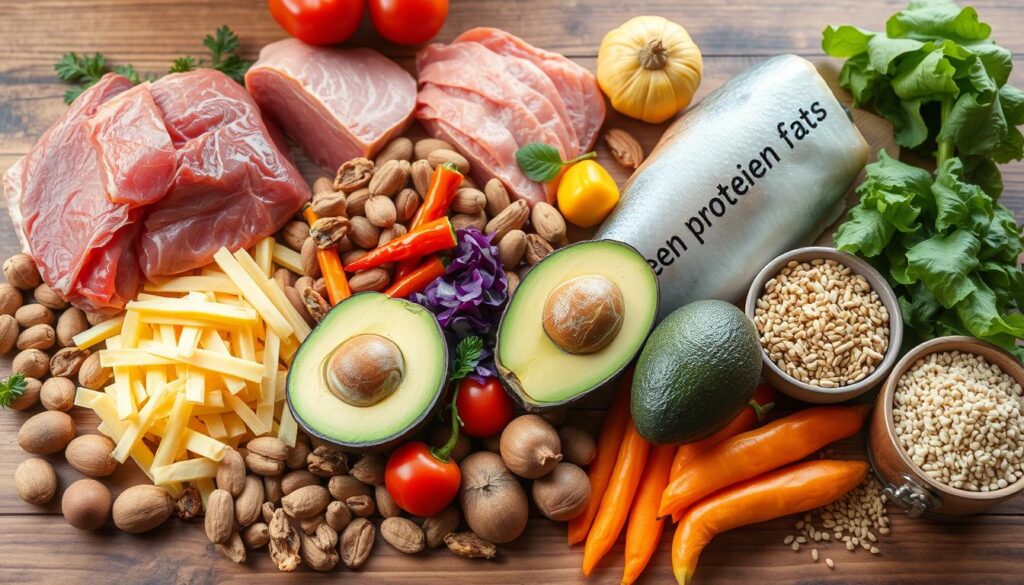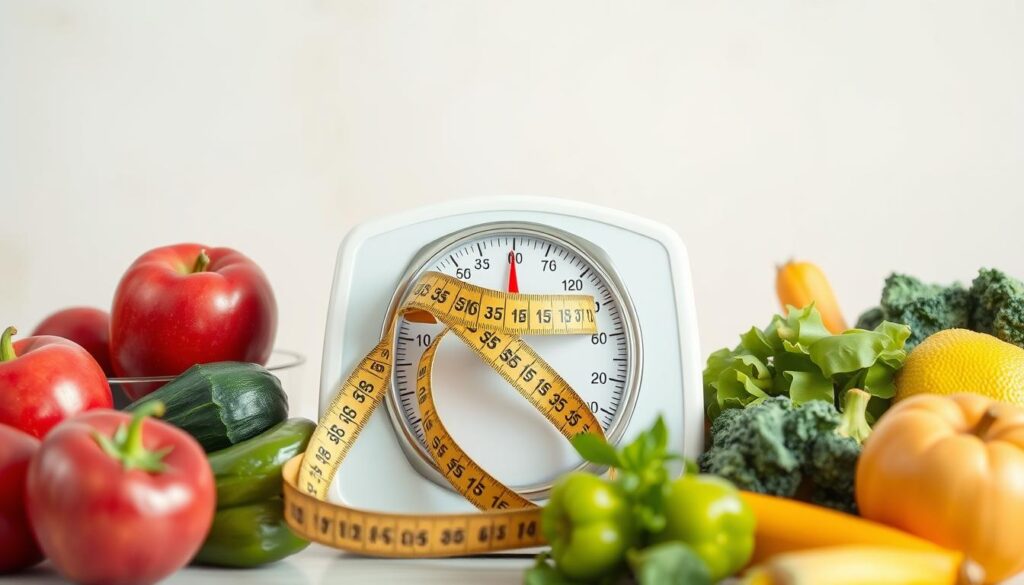Understanding the difference between weight loss and fat loss is key for your health. These terms are often mixed up, but they mean different things. We’ll look at why focusing on fat loss is better for you.
Key Takeaways
- Weight loss means losing weight, including muscle, water, and fat. Fat loss is about losing just the extra fat.
- Going for fat loss is better for your health. It can lower obesity, diabetes, and heart disease risks.
- Building muscle helps burn more calories. It also keeps your metabolism healthy and your muscles strong while losing weight.
- It’s important to watch your progress, not just by how much you weigh. Look at body composition changes too.
- To lose fat well, eat fewer calories and exercise regularly. Include strength training and cardio in your routine.
Understanding Body Composition Basics
When you want to lose weight, knowing what makes up your body is key. Your body has fat, muscle, and water. Keeping these in balance is important for health and how your body works.
What Makes Up Your Total Body Weight
Your body weight is made up of different parts. Body composition includes fat and muscle. Water makes up a big part of your body too.
The Role of Lean Body Mass
Lean muscle is key for a healthy body. It helps your body work right. To lose weight without losing muscle, do resistance training and eat well.
Understanding Water Weight
Water weight changes for many reasons. Things like salt, hormones, and how much water you drink affect it. Drinking more water and eating less salt can help.
Knowing about your body’s parts helps you lose fat and keep muscle. This leads to better, lasting weight loss.
“Maintaining a healthy fat-to-muscle ratio is essential for overall health and metabolism.”
Weight Loss Versus Fat Loss: Key Differences
When you want to get healthier, knowing the difference between weight loss and fat loss is key. Both can make you look smaller, but they affect your body in different ways.
Weight loss means you lose fat, muscle, and water. This can make the scale go down, but it might hurt your health. Fat loss, on the other hand, just cuts down body fat. This is better for your health and fitness in the long run.
When you lose muscle, it can slow down your metabolism. This raises the risk of serious diseases. It’s important to use body fat percentage to see if you’re losing fat or just weight.
| Metric | Weight Loss | Fat Loss |
|---|---|---|
| Body Composition | Decrease in fat, muscle, and water | Decrease in fat while preserving muscle |
| Metabolic Impact | Potential decline in metabolism | Maintenance or increase in metabolism |
| Health Outcomes | Increased risk of chronic diseases | Improved overall health and wellbeing |
| Sustainability | Harder to maintain long-term | More sustainable for long-term success |
Knowing the difference between weight loss and fat loss helps you make better choices. Aim for fat loss to keep your body healthy and strong.
“Losing fat, not just weight, should be your primary goal for better health and body composition.”
Why Fat Loss Should Be Your Primary Goal
When you want a healthy body, focus on fat loss more than just losing weight. Losing weight is good, but losing fat is better. It’s about having the right mix of fat and muscle in your body.
Health Benefits of Targeted Fat Loss
Choosing fat loss over weight loss is healthier. Keeping your body fat in a healthy range lowers disease risks. It helps prevent heart disease, diabetes, and some cancers.
Impact on Metabolic Health
Going for fat loss means you keep or grow muscle. Muscle burns more calories than fat. This helps keep your metabolism strong and supports sustainable weight management.
Long-term Sustainability
Choosing fat loss helps you keep your goals for health and fitness. Crash diets harm your metabolism and make it hard to keep weight off. By focusing on fat loss, you lose fat, not muscle, for lasting success.
“Maintaining muscle mass during weight loss is crucial for preserving metabolic rate and overall health.”
| Metric | Healthy Range |
|---|---|
| Body Fat Percentage (Women) | 14-31% |
| Body Fat Percentage (Men) | 6-24% |
| Waist-to-Hip Ratio (Women) | Below 0.85 |
| Waist-to-Hip Ratio (Men) | Below 0.90 |
The Science Behind Fat Loss and Metabolism
To lose body fat, you need to know the science. Fat loss happens when you burn more calories than you eat. Your metabolism is key in burning fat.
Your muscle mass helps you burn calories even when you’re not moving. More muscle means more calories burned. Also, hormones and genetics affect how you store and lose fat.
Studies found over 400 genes linked to obesity. Your body might have a set point weight it tries to keep. This is influenced by genetics, age, and hormones. Knowing this can help you find better ways to lose fat.
| Factors Influencing Fat Burning | Impact on Metabolism |
|---|---|
| Muscle Mass | Higher muscle mass leads to a higher resting metabolic rate, allowing your body to burn more calories at rest. |
| Hormones | Hormonal imbalances can affect how your body stores and metabolizes fat. |
| Genetics | Certain genetic factors can predispose individuals to obesity and make fat loss more challenging. |
Learning about fat burning, metabolism, and what affects them helps you lose fat better. It makes your fat loss plan more effective and lasting.
How to Measure Your Progress Effectively
Measuring your weight loss is more than just stepping on the scale. Your muscles can grow from working out. This means your body gets better, but the scale might not show it right away. So, it’s good to measure your body too, not just your weight.
Body Fat Measurement Tools
Tools like bioelectrical scales or DEXA scans can tell you a lot about your body. But, they might not be easy to find. At home, you can use skin calipers to guess your body fat percentage. But, how well it works depends on who is using it.
Beyond the Scale Methods
- Measure your bust, waist, hips, thighs, and arms to track changes in your body shape and size.
- Looking in the mirror and taking pictures every week can show you how your body is changing.
- Take your weight and measure your waist, hips, and thighs every month. This helps when you’re not losing weight fast.
Tracking Body Composition Changes
For accurate measurements, wear clothes that fit well or nothing at all. Take each measurement twice and use the average. This way, you can track your progress better.
| Body Part | Measurement Location |
|---|---|
| Abs | Just above the navel |
| Arms | Midway between the shoulder and elbow |
| Calves | Widest part of the calf |
| Chest | Fullest part of the chest |
| Hips | Fullest part of the hips and buttocks |
| Thighs | Midway between the hip and knee |
| Waist | Smallest part of the waist, usually just above the navel |
Tracking your measurements regularly can give you confidence and motivation. It also shows if your workout and diet plans are working. Talking to a healthcare provider about your weight loss goals can also help you stay on track.
Nutrition Strategies for Optimal Fat Loss
To lose unwanted body fat, focus on good nutrition. A balanced diet with fewer calories is key. This helps you lose fat without harming your health.
Eating more protein is great for losing fat. Protein keeps your muscles strong and makes you feel full. Include foods like chicken, fish, eggs, and beans in your meals.
It’s also important to eat the right amount of carbs and healthy fats. Don’t cut out whole food groups. This can lead to missing important nutrients and make it hard to stick to your diet.
Try to eat 500-600 fewer calories each day. This slow, steady weight loss won’t make you too hungry or tired. Eat foods like fruits, veggies, and lean proteins to do this without feeling left out.
Stay away from junk foods, sugary drinks, and snacks with no nutrients. They can stop you from losing fat. Drink plenty of water to help your body burn fat better.
| Macronutrient | Recommended Intake for Fat Loss |
|---|---|
| Protein | 0.7-1.0 grams per pound of body weight |
| Carbohydrates | 40-50% of total daily calories |
| Fats | 20-30% of total daily calories |
By using these nutrition tips, you can lose fat in a healthy way. This supports your overall health and well-being.

The Role of Exercise in Fat Loss
Exercise is key for losing unwanted fat. Weight loss and fat loss are different. Focusing on fat loss helps keep lean muscle mass, boosts metabolism, and leads to a healthier body.
Strength Training Benefits
Strength training is a big help for fat loss. It keeps your lean muscle mass while you lose weight. This is good for a healthy metabolism.
Building and keeping muscle means you burn more calories, even when you’re not moving. This makes it easier to lose fat.
Cardio vs. Resistance Training
Both cardio and resistance training help with fat loss. But mixing both is best. Cardio, like HIIT, boosts your metabolism and burns calories. Resistance training keeps and grows lean muscle mass.
Workout Programming Tips
- Do 150-300 minutes of exercise each week, says the CDC.
- Combine cardio and resistance training. Focus on getting stronger to keep losing fat and growing muscle.
- Try HIIT workouts to burn more calories and boost your metabolic rate.
- Make sure to rest enough to avoid burnout and help muscles heal and grow.
Finding an exercise routine you like is key for fat loss. Mix strength training and cardio to lose fat and keep or grow lean muscle mass.
Common Mistakes to Avoid During Fat Loss
Getting to a healthy weight is hard, but you can avoid some big mistakes. One big mistake is eating too few calories. This can make you lose muscle and slow down your metabolism. This makes it harder to lose fat in the long run.
Another mistake is only doing cardio to lose fat. Cardio is good, but you also need to do strength training. Strength training keeps your muscles strong. This is important for a healthy metabolism and a toned body.
- Avoid extreme calorie restriction, which can lead to muscle loss and a slower metabolism.
- Don’t rely solely on cardio for fat loss; incorporate strength training to preserve lean muscle mass.
- Ensure adequate protein intake to support muscle maintenance and fat loss.
- Prioritize proper recovery between workouts to prevent overtraining and injury.
- Steer clear of crash diets and focus on sustainable lifestyle changes for long-term success.
Not tracking your progress and having too high hopes can also stop you. It’s good to check how you’re doing, like with body measurements or photos. Slow and steady is often the best way to keep weight off for good.
| Common Fat Loss Mistakes | Recommended Strategies |
|---|---|
| Extreme calorie restriction | Aim for a moderate calorie deficit of 400-500 calories per day |
| Neglecting strength training | Incorporate resistance training to preserve lean muscle mass |
| Inconsistent tracking and unrealistic expectations | Monitor progress regularly and set achievable goals (1-2 lbs per week) |
| Inadequate protein intake | Consume 0.8 grams of protein per kg of body weight per day |
| Insufficient recovery between workouts | Allow for proper rest and recovery to prevent overtraining and injury |
| Crash diets and unsustainable lifestyle changes | Focus on gradual, sustainable changes for long-term success |
By avoiding these mistakes and using good strategies, you can reach your fat loss goals. You’ll also stay healthy and feel good.

Maintaining Muscle While Losing Fat
When you want to lose weight, focus on losing fat, not just weight. Keeping your lean muscle mass is key for a healthy metabolism. Here’s how to keep your muscle while losing fat:
- Eat enough protein: Aim for 0.8 to 1 gram of protein per pound of body weight. This helps keep and grow your muscles.
- Do strength training: Work out with weights 2-3 times a week. This keeps your muscles strong and prevents them from shrinking.
- Keep your calorie intake right: Cut your daily calorie intake by 10-20%. This helps you lose fat without losing muscle.
- Eat well after working out: Have a meal or shake with protein, carbs, and healthy fats after exercising. This helps your muscles recover and grow.
- Get enough sleep and manage stress: Rest and stress control are vital for keeping your muscles and staying healthy.
- Make your workouts harder: Slowly make your workouts more intense. This challenges your muscles and helps them grow.
Remember, keeping lean muscle mass while losing fat is all about body composition, not just the scale. With the right diet and exercise, you can reach your fat-loss goals and keep your muscle.
“Muscle is the engine of the body, and without it, you won’t be able to burn fat effectively. Prioritize strength training and protein intake to keep your metabolism firing on all cylinders.”
Conclusion
Weight loss and fat loss are different. Losing weight doesn’t always mean you’re losing fat. The goal is to lose fat for better health.
Changing your body’s fat composition is key. This way, you can keep the weight off for good.
To lose fat, eat right, exercise, and live healthy. Keep track of your progress and make changes as needed. Getting help from doctors or trainers can also be very helpful.
Focus on losing fat, not just weight. A healthy lifestyle is the best way to manage your weight. With the right plan, you can feel better and look great.


A Life-Changing Experience with This Weight Loss Supplement (Nagano Tonic)
I’ve always struggled with finding a weight loss solution that actually works for me. Like many, I’ve tried numerous diets, exercise routines, and supplements over the years—some worked for a short time, but nothing ever gave me long-term results. That was until I decided to try the weight loss supplement I found : Link to the Supplement.
From the moment I started using it, I noticed a difference. Not only did I feel more energized, but my cravings also became more manageable. The best part? I started seeing results much quicker than I anticipated! Over the course of just a few weeks, I noticed a significant reduction in belly fat and overall weight loss that I hadn’t been able to achieve before.
What makes this supplement stand out from all the others I’ve tried is how it supports me in my daily routine without any jitters or energy crashes. I’m able to stay focused and motivated, which has made it easier to stay on track with my diet and exercise plan.
This product truly exceeded my expectations, and I feel more confident and healthier than ever before. If you’re struggling with your weight loss journey like I was, I highly recommend giving this supplement a try. It’s been a game-changer for me, and I’m sure it can work wonders for you too!
Contant Them on email .. tonicnagano50@gmail.com
wasn’t sure what to expect, but this weight loss supplement has really impressed me! After just a few weeks of use, I’ve already dropped a few pounds and feel more motivated to stay active. It’s helped curb my cravings and boosted my energy throughout the day. I’m excited to keep going and see even better results. Definitely worth trying!
Reach them on tonicnagano50@gmail.com
I’ve tried so many weight loss products, but this one has been by far the most effective. In just a few weeks, I’ve noticed a visible difference in my body and energy levels. It’s helped me stay on track without the constant hunger pangs and cravings. I’m really happy with my progress and can’t wait to see where I’ll be in another month!
This Nagano Tonic has been amazing! In just a few weeks, I’ve lost weight, feel more energized, and my cravings are under control. Highly recommend it!
Thats the link to purchase http://surl.li/iasppy